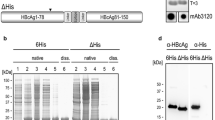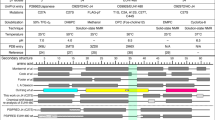Abstract
Hepatitis delta antigen (HDAg) must form oligomers to be biologically active. Quadrin (HDAg-(12–60)-Tyr) is a 50-residue protein segment from the oligomerization domain of HDAg. The crystal structure of quadrin shows an octamer consisting of four identical copies of a dimer containing an antiparallel α-helical coiled coil. Each end of the dimer contains an oligomerization site that interacts isologously with the oligomerization site of another dimer to form a right-angled corner. The resulting quadrin octamer is a 400-residue square protein surrounding a large aqueous hole. We have designed, chemically synthesized, and characterized deltoid and reduced deltoid, two 51-residue chimeric proteins that structurally and functionally mimic one of the two oligomerization sites of the quadrin dimer. Dimerization of deltoid or reduced deltoid should emulate the dimerization of two quadrin dimers to form one right-angled corner of the square. Deltoid and reduced deltoid were designed by molecular modeling, mechanics, and dynamics and synthesized by the solid-phase method. The amino acid sequence of deltoid (GREDILEQWVSCRKKL + PKAPPEE + LRKLKKKCKKLEEDNPWLGNIKGIIGKY) is a chimera of three protein segments: HDAg-(12–28), Thermus thermophilus serine tRNA synthase-(59–65), and HDAg-(34–60)-Tyr. Cysteine (C) was introduced at two positions to explore the effects of the presence (deltoid) or absence (reduced deltoid) of an interhelical disulfide bond. Circular dichroic spectropolarimetry revealed that both synthetic proteins form an α-helical structure that is stable over a wide range of pH and KCl concentrations. Size-exclusion chromatography indicated that deltoid and reduced deltoid each form a dimer. Interconversion of these monomers and dimers should be useful model systems for studying the structural features of the right-angled corners of the quadrin octamer that contribute to HDAg oligomerization. If, like quadrin, deltoid or reduced deltoid interferes with HDAg oligomerization, it might serve as a lead compound for the design of potent HDV inhibitors.
Similar content being viewed by others
References
Rizzetto, M., Hepatology, 3 (1983) 729.
Hoofnagle, J.H., J. Am. Med. Assoc., 261 (1989) 1321.
Rizzetto, M., Hoyer, B., Canese, M.G., Shih, J.W.K., Purcell, R.H. and Gerin, J.L., Proc. Natl. Acad. Sci. USA, 77 (1980) 6124.
Lai, M.M.C., Annu. Rev. Biochem., 64 (1995) 259.
Xia, Y.P. and Lai, M.M.C., J. Virol., 66 (1992) 6641.
Chao, M., Hsieh, S.Y. and Taylor, J., J. Virol., 64 (1990) 5066.
Rozzelle, J.E., Wang, J.G., Wagner, D.S., Erickson, B.W. and Lemon, S.M., Proc. Natl. Acad. Sci. USA, 92 (1995) 382.
Zuccola, H.J., Rozzelle, J.E., Lemon, S.M., Erickson, B.W. and Hogle, J., Structure, in press.
Eliel, E.L. and Wilen, S.H., Stereochemistry of Organic Compounds, Wiley, New York, NY, 1994.
Hermans, J., SIgMA Documentation, University of North Carolina at Chapel Hill, Chapel Hill, NC, U.S.A., 1994.
Kraulis, P.J., J. Appl. Crystallogr., 24 (1991) 946.
Bacon, D.J. and Anderson, W.F., J. Mol. Graph., 36 (1987) 219.
Merrit, E.A. and Murphy, M.E.P., Acta Crystallogr., D50 (1994) 869.
Murzin, A.G., Brenner, S.E., Hubbard, T. and Chothia, C., J. Mol. Biol., 247 (1995) 536.
Fujinaga, M., Berthet-Colominas, C., Yaremchuk, A.D., Tukalo, M.A. and Cusack, S., J. Mol. Biol., 234 (1993) 222.
Ponder, J.W. and Richards, F.M., J. Mol. Biol., 193 (1987) 775.
Richardson, J.S., In Anfinsen, C.B., Edsall, J.T. and Richards, F.M. (Eds.) Advances in Protein Chemistry, Vol. 34, Academic Press, New York, NY, 1981, pp. 168–339.
Hutchinson, E.G. and Thornton, J.M., Protein Sci., 5 (1996) 212.
Chen, Y.H., Yang, J.T. and Chau, K.H., Biochemistry, 13 (1974) 3350.
Lau, S.Y.M., Taneja, A.K. and Hodges, R.S., J. Biol. Chem., 259 (1984) 13253.
Oakley, M.G. and Kim, P.S., Biochemistry, 36 (1997) 2544.
Su, Y.S., Hodges, R.S. and Kay, C.M., Biochemistry, 33 (1994) 15501.
Author information
Authors and Affiliations
Rights and permissions
About this article
Cite this article
Saderholm, M.J., Erickson, B.W. Engineering of deltoid and reduced deltoid: Two chimeric proteins containing the oligomerization site of the hepatitis delta antigen. Letters in Peptide Science 6, 23–32 (1999). https://doi.org/10.1023/A:1008811309904
Issue Date:
DOI: https://doi.org/10.1023/A:1008811309904




